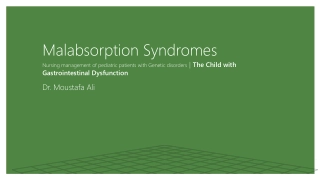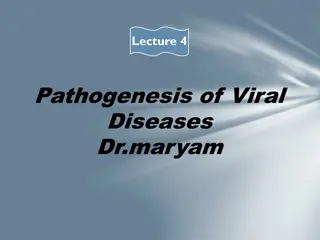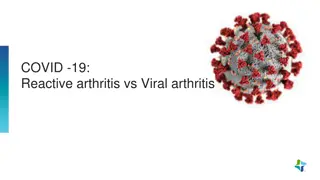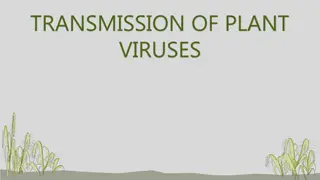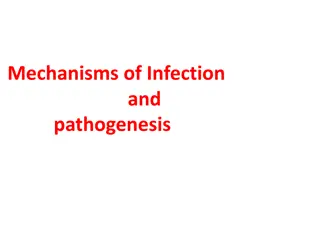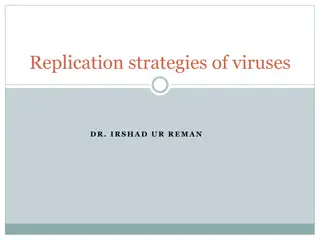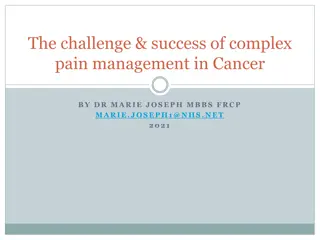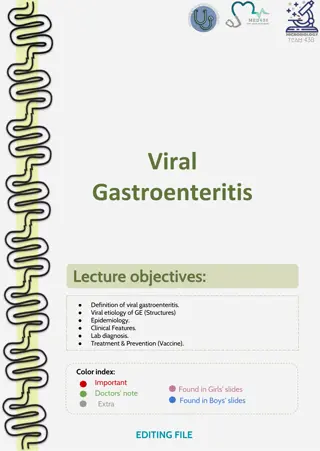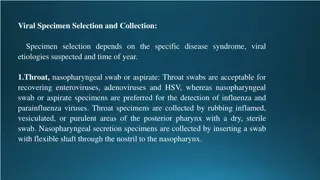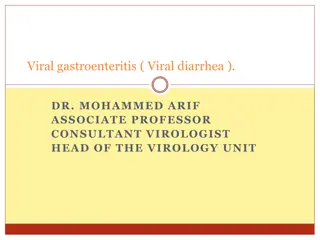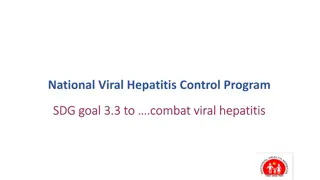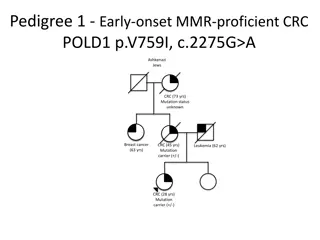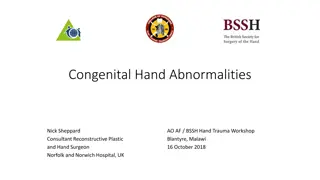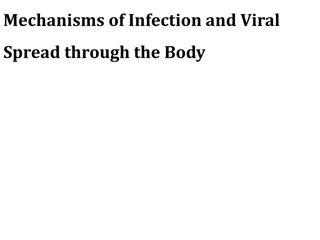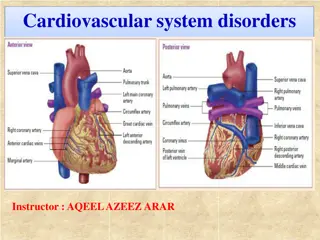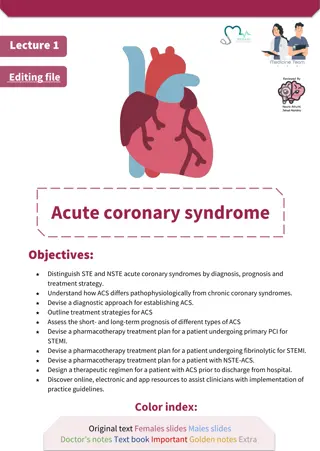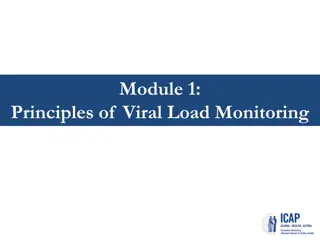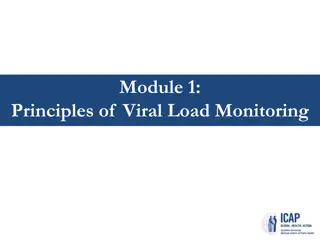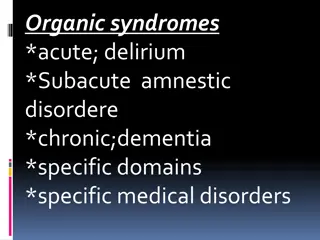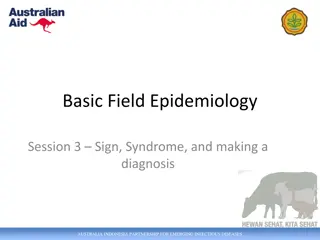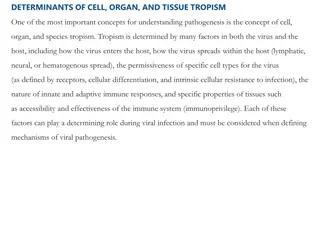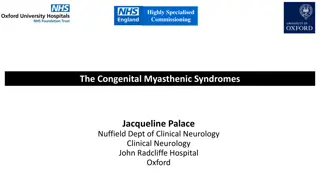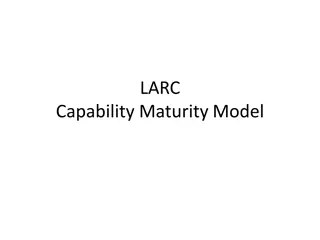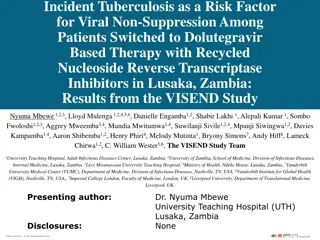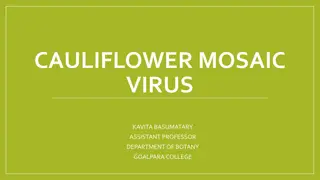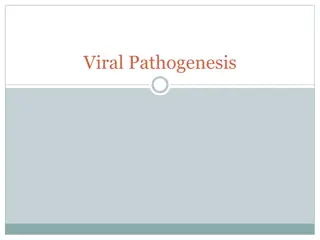Malabsorption Syndromes
The nursing management of pediatric patients with malabsorption syndromes, including identification of common gastrointestinal problems, implementation of the nursing process, and nutritional therapies.
31 views • 24 slides
Diagnosis and Management of Acute HIV Infection
Guideline aims to recognize the risks, signs, and symptoms of acute HIV infection and to promote HIV testing in individuals presenting with flu-like symptoms or viral syndromes. It provides recommendations for diagnostic testing, treatment, and prevention services to improve patient health and reduc
0 views • 19 slides
Understanding Viral Vectors in Gene Delivery: Safety and Considerations
Exploring the mechanisms of gene delivery via viral vectors, this content delves into the basics of viral structure, infection, and replication. It discusses common viral vector systems like Adenoviral and Lentiviral vectors, highlighting safety considerations and the production processes involved.
1 views • 19 slides
Understanding Viral Pathogenesis: Insights into Disease Development
Viral pathogenesis explores the intricate relationship between viruses and their hosts, encompassing factors like viral effects on cells, entry mechanisms, tissue tropism, immune responses, and the outcomes of infection. This process involves a series of interactions leading to either virus clearanc
1 views • 29 slides
A Scientific Approach to Pandemic Preparedness
Barney S. Graham, MD, PhD, outlines a scientific framework for epidemic and pandemic research preparedness to achieve fast and equitable access to high-quality vaccines for future pandemics. The discussion covers new human viral pathogens, 21st-century viral threats, viral taxonomy, and a prototype
0 views • 16 slides
Understanding Viral Diseases in Poultry: Newcastle Disease and Avian Influenza
Viral diseases like Newcastle Disease (ND) and Avian Influenza (AI) pose significant threats to poultry farming, impacting bird health and production. ND, caused by Avian paramyxovirus type 1, is highly contagious and manifests in various forms affecting birds' respiratory and nervous systems. On th
7 views • 24 slides
Uptake of Viral Load Testing and Viraemic Episodes During Pregnancy in Johannesburg, South Africa
This study investigates the uptake of viral load testing and frequency of viraemic episodes during pregnancy among HIV-positive mothers in Johannesburg, South Africa. Data from a cohort of mothers and infants born at a local hospital were linked to laboratory data for analysis. The results show the
2 views • 12 slides
Understanding COVID-19's Impact on Joint Health: Reactive Arthritis vs Viral Arthritis
Explore the distinction between reactive arthritis and viral arthritis in the context of COVID-19, discussing symptoms, triggers, and potential long-term consequences on joint health. Learn how viral infections can lead to acute arthralgia and arthritis, including common pathogens such as Hepatitis
0 views • 30 slides
The Transmission and Movement of Plant Viruses
Plant viruses are transmitted through various means such as cell-to-cell movement via plasmodesmata and systemic spread through vascular tissues. The viral proteins and mechanisms facilitating these movements are crucial for viral infection and spread within plant hosts. Understanding the different
0 views • 47 slides
Virus Entry Mechanisms: Understanding Pathogenesis and Spread
Exploring the diverse ways viruses enter the body through various routes such as respiratory tract, oropharynx, skin, genitourinary tract, and eyes, shedding light on the steps of the virus life cycle shaping pathogenesis. Viral diseases result from the intricate interaction between viral and host f
4 views • 20 slides
Viral Genome Replication Strategies and Mechanisms
Viruses utilize different replication strategies to ensure the replication of viral genomes, packaging into virions, and potentially altering the host cell's structure or function. These strategies are vital for the virus to operate effectively within the host cell's constraints. The replication pro
0 views • 15 slides
Complexity in Cancer Pain Management by Dr. Marie Joseph
Dr. Marie Joseph explores the challenges and successes of managing complex pain in cancer patients. The intricacies of neuropathic pain, diagnostic characteristics, pathophysiology, pharmacology, and typical cancer pain syndromes are discussed. Strategies such as co-analgesic adjuvants, analgesic sy
0 views • 12 slides
Overview of Viral Gastroenteritis: Etiology, Epidemiology, Clinical Features, Diagnosis, and Treatment
Viral gastroenteritis is an inflammation of the gastrointestinal tract primarily affecting the stomach and small intestine, leading to symptoms like acute diarrhea and vomiting. It can be caused by various infectious agents such as Rotavirus, Adenovirus, Caliciviruses, Astrovirus, Coronavirus, Torov
1 views • 7 slides
Capability Maturity Model Cascade and Viral Load Testing Stages
This content discusses the Capability Maturity Model stages, focusing on process improvement and the stages of viral load testing demand creation. It outlines the evolution from initial to optimized stages and the development towards standardized processes in organizations. Additionally, it touches
3 views • 8 slides
Viral Specimen Selection and Collection Overview
Specimen selection for viral testing depends on the suspected viral etiologies and disease syndrome. Throat and nasopharyngeal swabs are used for different viruses, while rectal swabs, urine, blood, and tissue samples are also collected for specific viral detection. Proper specimen transport and sto
0 views • 7 slides
Understanding Bovine Virus Diarrhea and Mucosal Disease in Cattle
Bovine Virus Diarrhea (BVD) and Mucosal Disease (MD) are two clinically distinct yet interconnected syndromes in cattle caused by Pestivirus. While originally thought to be separate, they share a common viral etiology. BVD can lead to persistent infections, while MD is sporadic, progressive, and fat
0 views • 14 slides
Understanding Viral Gastroenteritis: Causes, Symptoms, and Transmission
Viral gastroenteritis, commonly known as viral diarrhea, is a prevalent infection affecting mainly infants and young children. The disease is self-limiting, with symptoms like diarrhea, vomiting, and abdominal pain. Key viral etiologies include Rota viruses, Astroviruses, Norovirus, and Enteric aden
0 views • 19 slides
National Viral Hepatitis Control Program - Achieving Universal Health Coverage and Elimination Goals
The National Viral Hepatitis Control Program in India is working towards combating viral hepatitis and achieving SDG goal 3.3 through a comprehensive approach that includes awareness generation, prevention, management, and financing under the NHM. The aim is to eliminate hepatitis C by 2030, reduce
0 views • 19 slides
Familial Colorectal Cancer Syndromes: Genetic Profiles and Clinical Presentations
These pedigrees depict familial colorectal cancer syndromes in Ashkenazi and Iraqi Jews, showcasing early-onset MMR-proficient CRC cases linked to mutations in POLD1 and POLE genes. The pedigrees detail various cancer diagnoses, mutation carrier statuses, and ages of onset across multiple generation
0 views • 5 slides
Understanding Congenital Hand Abnormalities and Associated Syndromes
Explore congenital hand abnormalities such as macrodactyly, trigger thumb, clasped thumb, preaxial deficiency, and syndromes like Holt-Oram Syndrome and Fanconi Anemia. Learn about assessment, intervention plans, and common treatments provided by experts in reconstructive plastic and hand surgery.
1 views • 26 slides
Zimbabwe Viral Load Clinic: Laboratory Interface Learning Session and Country Context Update
Zimbabwe hosted a vital learning session on viral load clinic laboratory interfaces and the epidemiology of HIV in the country. The session aimed to sensitize participants on the VL CLI, introduce the LARC team, and identify gaps in managing clients on ART with high viral loads. The country context
0 views • 18 slides
Viralizing YouTube Videos: Key Insights and Strategies
YouTube, a giant in user-generated video content, offers immense potential for videos to go viral. Understanding the dynamics of viralization on YouTube is crucial for content creators. This chapter delves into the phenomena of viral videos on YouTube, explores key factors that contribute to a video
0 views • 42 slides
Understanding Mechanisms of Viral Infection and Spread
Viral infection involves a replicative cycle within the host, leading to a range of cellular responses from no apparent effect to disease. Factors such as virulence genes, host characteristics, and viral genome influence the pathogenicity and virulence of a virus. The process includes entry into the
0 views • 16 slides
Understanding Acute Coronary Syndromes: Causes, Symptoms, and Risk Factors
Acute coronary syndromes (ACS) encompass a spectrum of conditions such as unstable angina, non-ST-segment elevated MI (NSTEMI), and ST-segment elevated MI (STEMI) that result from coronary artery occlusion. Risk factors for ACS include family history of heart disease, obesity, smoking, and hypertens
0 views • 20 slides
Understanding Acute Coronary Syndrome Differentiation and Treatment
Learn to distinguish between STE and NSTE acute coronary syndromes in terms of diagnosis, prognosis, and treatment strategies. Understand the pathophysiological differences between ACS and chronic coronary syndromes. Gain insight into diagnostic approaches, treatment regimens, and prognosis for vari
0 views • 15 slides
Zimbabwe HIV Viral Load Testing Overview
Zimbabwe's plan to scale up HIV viral load testing from 2018 to 2020 is outlined, with targets set for each year. The country has made significant progress in expanding its viral load testing capacity, going from targeted testing to near-universal coverage by 2018. Various testing laboratories in Zi
0 views • 9 slides
Principles of Viral Load Monitoring in HIV Infection
Understanding viral load dynamics in HIV infection is crucial for managing treatment and transmission risks. Viral load monitoring helps assess response to antiretroviral therapy and identify treatment failure. Regular viral load testing is recommended for both adults and children on ART, allowing f
0 views • 40 slides
Principles of Viral Load Monitoring in HIV Patients
Explore the dynamics of viral load in HIV infection, its impact on transmission and disease progression, response to antiretroviral therapy, identification of treatment failure, and monitoring schedules. Understand the significance of viral load testing in managing HIV patients effectively.
0 views • 47 slides
Understanding Organic Syndromes: Delirium, Subacute Amnestic Disorder, and Chronic Dementia
Explore the spectrum of organic syndromes including delirium, subacute amnestic disorder, and chronic dementia. Delve into the definitions, statistics, causes, management strategies, classifications, and reversible dementias associated with these conditions.
0 views • 13 slides
Understanding Signs, Syndromes, and Diagnoses in Epidemiology Session
Explore the significance of signs of disease, syndromes, and making accurate diagnoses in the context of the Australia-Indonesia Partnership for Emerging Infectious Diseases. Engage in activities to differentiate between signs and syndromes, identify characteristics of healthy and unhealthy animals,
0 views • 18 slides
Understanding Viral Social Media Challenges and Making Informed Choices
Explore the prevalence and impact of viral social media challenges, reflect on why they become popular, and discuss the importance of making conscious decisions to participate or abstain. Delve into examples like the Paqui Challenge and the concept of trends going viral, highlighting the influence o
0 views • 16 slides
Understanding Determinants of Cell, Organ, and Tissue Tropism in Viral Pathogenesis
Cell, organ, and tissue tropism are crucial in viral pathogenesis, influenced by factors such as routes of entry and spread within the host, cell permissiveness, and immune responses. Viruses penetrate epithelial barriers through various mechanisms to establish infection, navigating specialized cell
0 views • 29 slides
Understanding Infectious Diseases: Approach, Prevention, and Viral Agents
Infectious diseases play a significant role in public health, with a focus on antibiotic stewardship, community-acquired and healthcare-associated infections, as well as various bacterial, viral, fungal, and parasitic agents. Specific topics include the prevention of infectious diseases, with a deta
0 views • 18 slides
Specialised Commissioning for Congenital Myasthenic Syndromes - Overview by Professor Jacqueline Palace
Delve into the highly specialised commissioning of Congenital Myasthenic Syndromes by Professor Jacqueline Palace from the Nuffield Department of Clinical Neurology at John Radcliffe Hospital, Oxford. Explore key messages, learning objectives, and disclosures related to diagnosing, differentiating,
0 views • 4 slides
Understanding the LARC Capability Maturity Model for Organizational Improvement
The LARC Capability Maturity Model (CMM) focuses on enhancing the viral load cascade, aiming to achieve better patient outcomes and improve institutional capabilities for viral load scale-up. Developed by Carnegie-Mellon University Software Engineering Institute in 1987, the CMM provides a structure
0 views • 14 slides
Canine Meningoencephalitis Study: Pan-Viral PCR Analysis
Study focuses on Canine Meningoencephalitis of unknown etiology using Pan-Viral PCR to detect infectious agents in cerebrospinal fluid samples. The research aims to identify aberrant immune responses in dogs with MUE. Consensus degenerate primers are used to target viral families like Herpesviridae,
0 views • 13 slides
Exploring Viral Spread Through Mathematical Modeling
Guide providing insights into viral transmission and exponential growth through a mathematical model programmed in Google Sheets. Students explore the impact of reproduction numbers (R0) on viral spread and strategies for reducing transmission. The resource includes instructional strategies, discuss
0 views • 8 slides
Tuberculosis as a Risk Factor for Viral Non-Suppression in Patients Switched to Dolutegravir-Based Therapy
The study investigates the impact of incident tuberculosis on viral non-suppression among patients transitioning to Dolutegravir-based therapy in Zambia. It aims to identify factors associated with viral non-suppression and describe clinical outcomes in the context of tuberculosis occurrence. The re
0 views • 13 slides
Understanding Cauliflower Mosaic Virus: Structure, Reproduction, and Genome
Cauliflower Mosaic Virus (CaMV) is a plant virus studied by Assistant Professor Kavita Basumatary at Goalpara College. The virus has a circular, double-stranded DNA genome of about 8000 bp in length with unique discontinuities. Reproduction involves the viral genome entering the host cell nucleus, w
0 views • 6 slides
Understanding Viral Pathogenesis: Causes and Consequences
Viral pathogenesis involves the process by which a virus leads to disease, exploring the interplay between viral and host factors. It encompasses the concepts of virulence, viral disease, and the effects on infected cells and the host's immune response. Changes within infected cells, including cell
0 views • 26 slides
